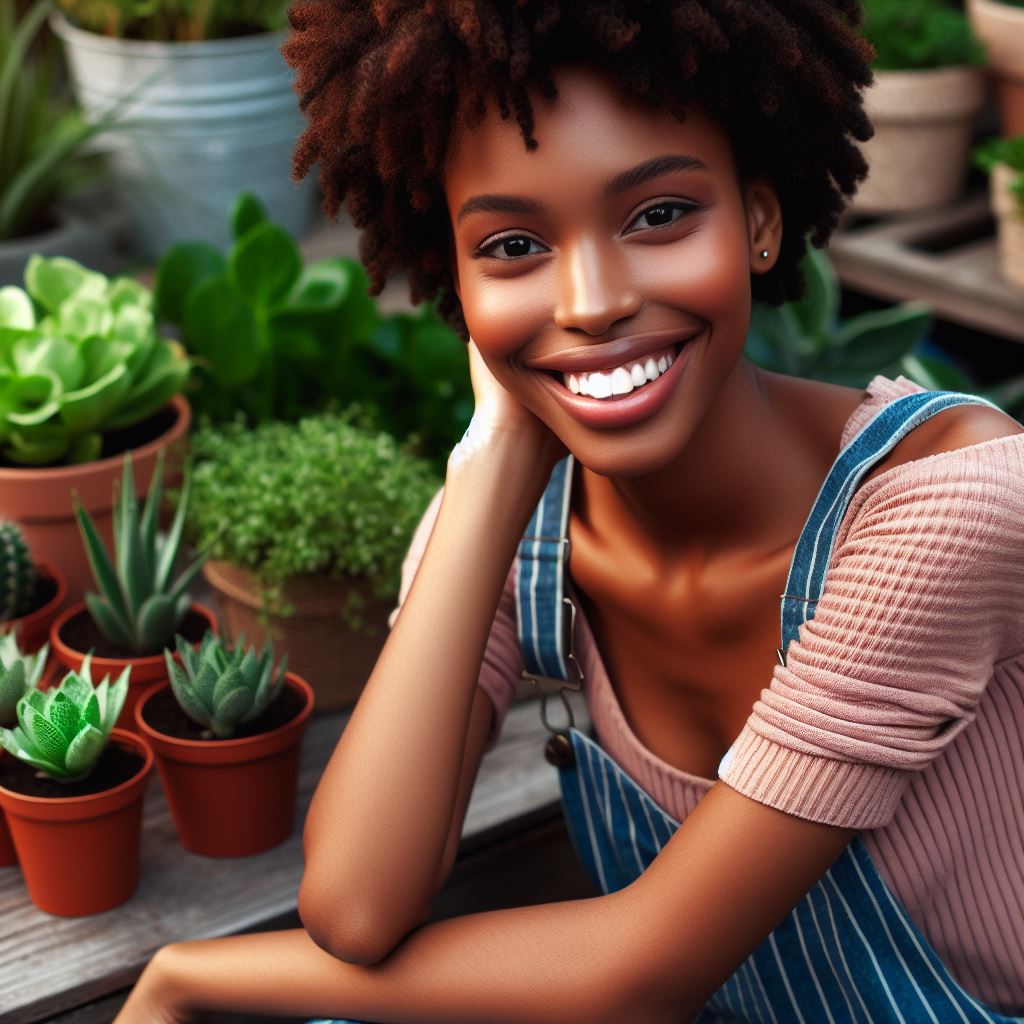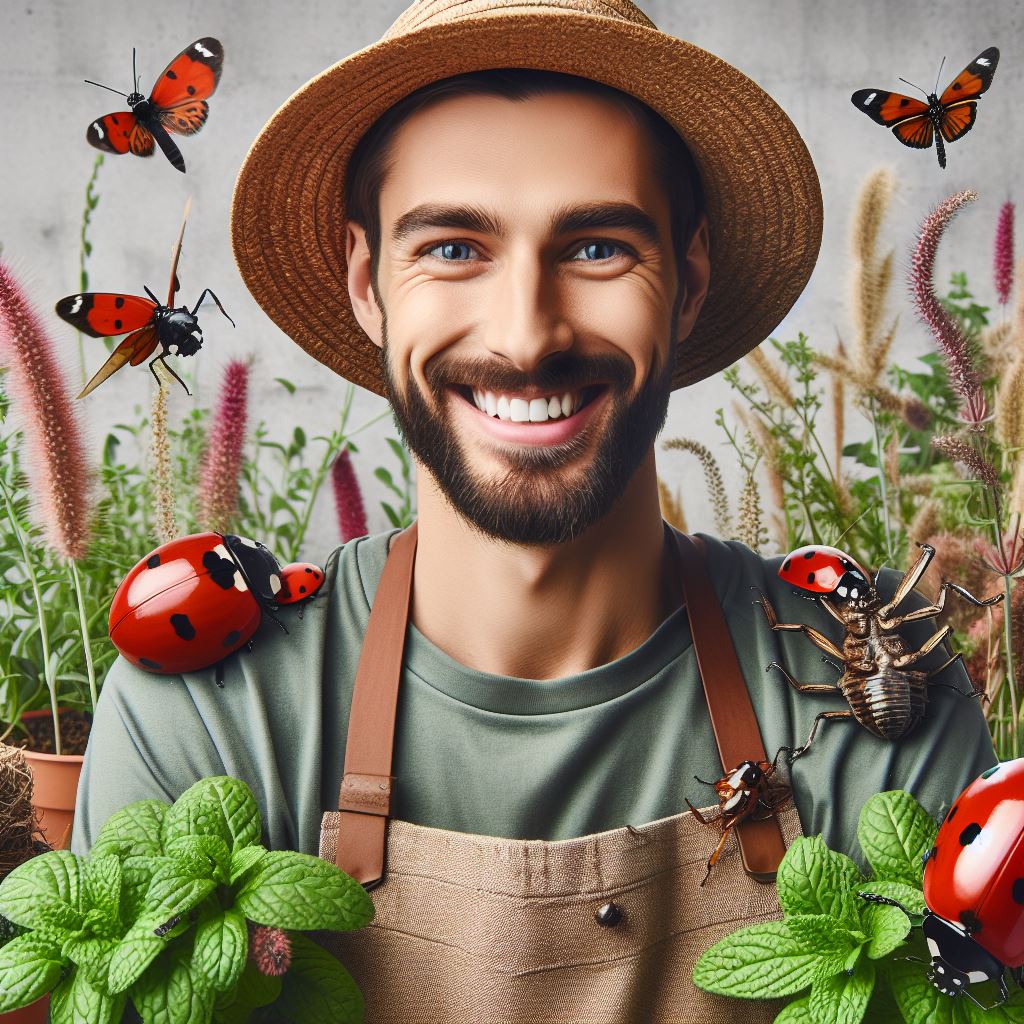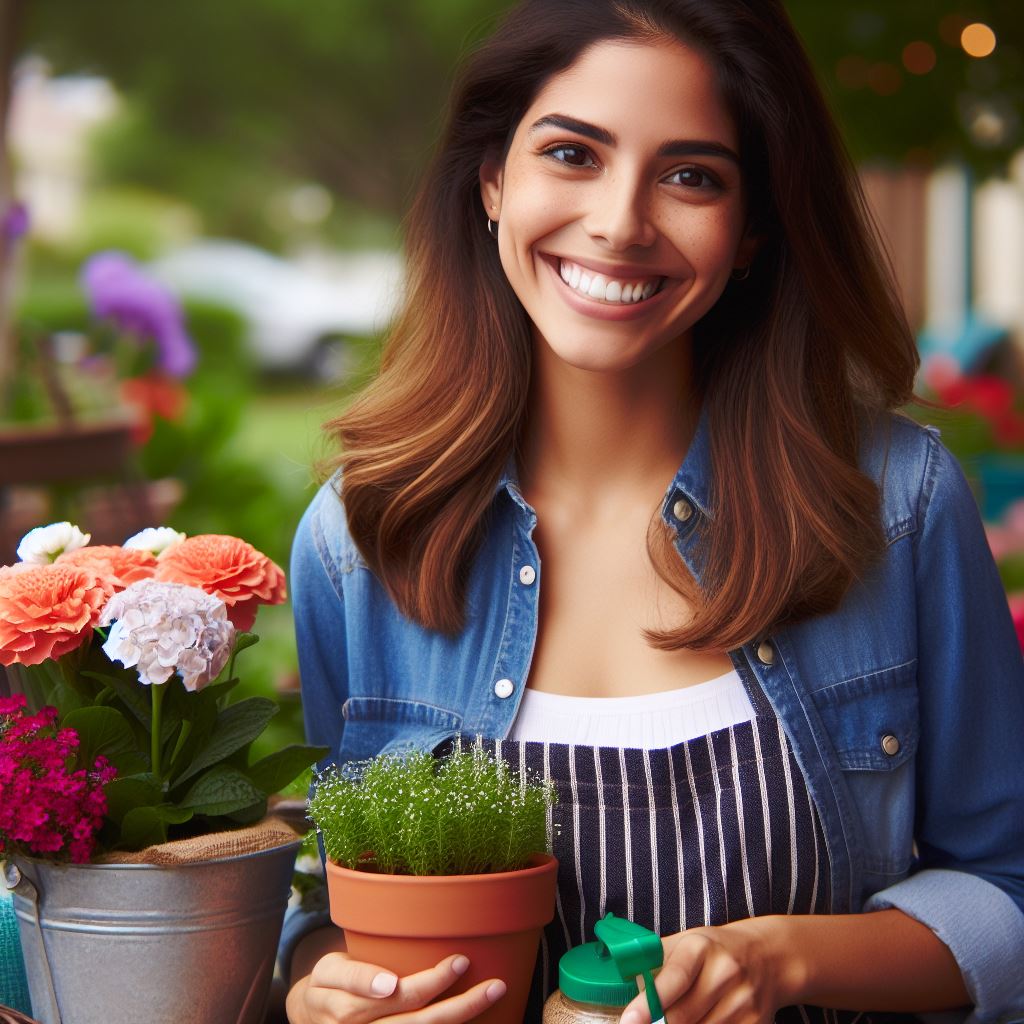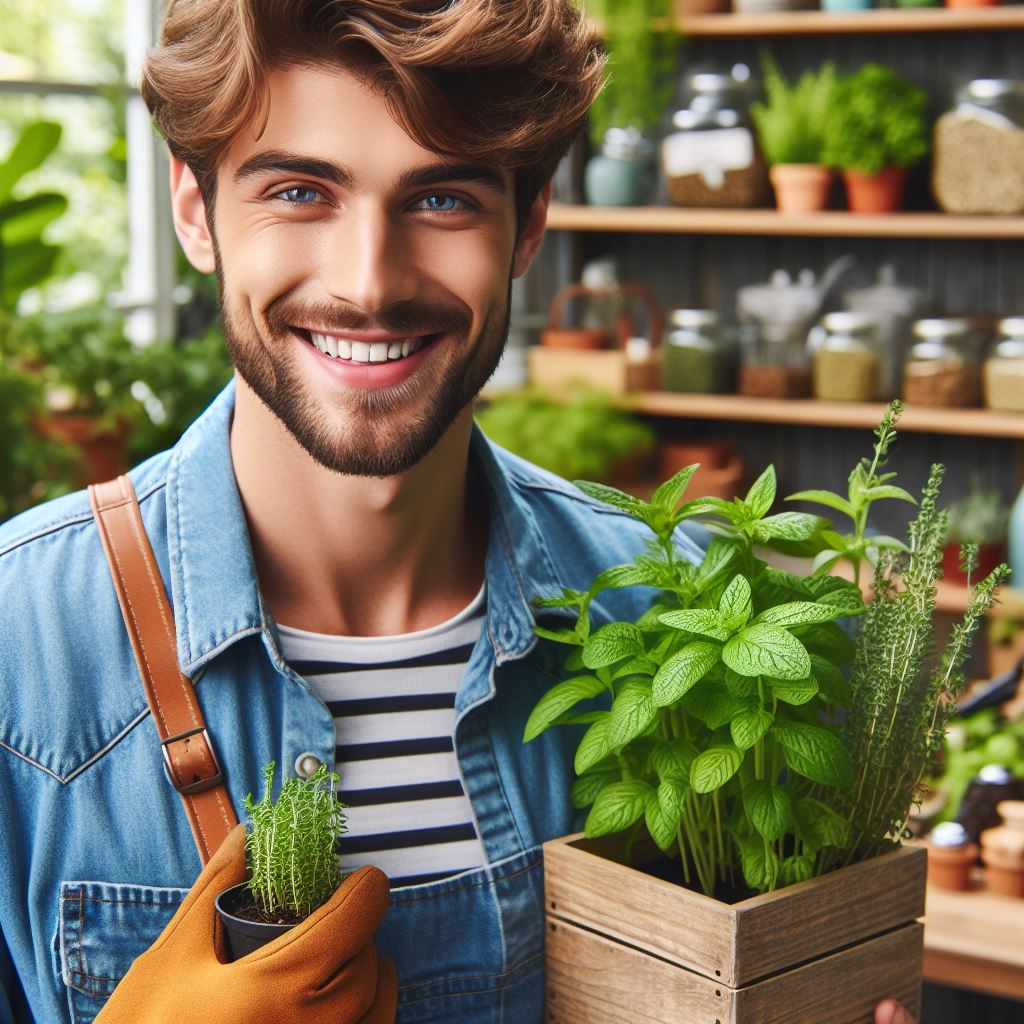Introduction
Container gardening is a versatile and beginner-friendly gardening method, perfect for those with limited space or mobility.
With container gardening, you can grow an assortment of plants, including flowers, herbs, and vegetables, even if you don’t have access to a traditional garden.
The appeal of container gardening lies in its simplicity and convenience. Beginners can easily get started without the need for extensive knowledge or experience.
It allows you to exercise your creativity by choosing different containers and plant varieties, adding a touch of beauty to your home or patio.
In this blog post, our aim is to provide a comprehensive beginner’s guide to container gardening.
We will cover everything you need to know, from selecting the right containers, soil, and plants to choosing the ideal location and providing proper care.
Whether you’re a gardening novice or simply looking to try something new, container gardening offers an exciting and rewarding experience.
So, if you’re ready to embark on your gardening journey and enjoy the benefits of a flourishing and vibrant mini-garden, keep reading.
We’re here to help you step by step as you dive into the world of container gardening.
Getting Started
Embarking on your container gardening journey requires thoughtful consideration of the containers you’ll use.
Selecting the right vessel lays the foundation for a thriving and vibrant garden.
Containers come in various forms: pots, buckets, and hanging baskets offer versatility for different plants and spaces.
Each option has unique characteristics that cater to specific gardening needs.
Tips for selecting the appropriate size and material for containers
When choosing containers, size matters. Opt for pots that match the mature size of your plants.
This prevents overcrowding and ensures adequate space for root development, promoting healthier, more robust growth.
Consider the material of your containers. Clay pots are porous, allowing better aeration, while plastic containers retain moisture efficiently.
Evaluate your plant’s water needs and choose a material that aligns with them.
Significance of drainage holes in containers
Drainage holes are non-negotiable. They play a pivotal role in preventing waterlogged soil, which can lead to root rot.
Ensure each container has sufficient drainage to maintain the right moisture balance.
Experiment with container arrangements, combining various sizes and shapes for visual appeal.
This not only enhances the aesthetic appeal of your garden but also provides a functional layout, allowing sunlight and air to reach each plant.
Before planting, disinfect used containers to eliminate any lingering diseases.
A quick soak in a mild bleach solution can help sterilize pots, ensuring a clean start for your plants.
Think vertically by utilizing hanging baskets. They save space and add a charming, cascading element to your garden.
Ideal for trailing plants like strawberries or petunias, hanging baskets can turn any vertical space into a lush display.
In smaller spaces, consider window boxes or railing planters.
These options maximize space efficiency and provide an opportunity to experiment with a variety of herbs, flowers, or even compact vegetables.
When selecting containers, prioritize durability.
Outdoor containers face the elements, so investing in sturdy, weather-resistant materials ensures longevity and minimizes the need for frequent replacements.
Don’t forget to consider the weight of your containers.
If you plan to move them around frequently or have weight restrictions, opt for lightweight materials.
This makes maintenance and rearrangement more manageable.
Transform Your Agribusiness
Unlock your farm's potential with expert advice tailored to your needs. Get actionable steps that drive real results.
Get StartedIn fact, choosing the right container is the first step to a successful container garden.
Tailor your selections to the unique needs of your plants, your available space, and your personal style.
With the right containers in place, you’re well on your way to creating a flourishing and beautiful garden sanctuary.
Read: Water-Saving Tactics in Organic Gardening
Selecting the Right Soil
Container gardening is a wonderful way to grow plants and vegetables, but it all starts with selecting the right soil.
This may seem like a trivial task, but it is actually one of the most important steps in ensuring healthy and thriving plants.
Importance of Using High-Quality Soil
Using high-quality soil is essential for container gardening success. It provides the necessary nutrients, water retention, and aeration for the plants to grow and flourish.
Choose a potting mix that is specifically formulated for container gardening.
Look for soil that is rich in organic matter and has good drainage properties.
Avoid using regular garden soil, as it may be too heavy and compact for container plants.
Characteristics of a Good Potting Mix
A good potting mix has several key characteristics that make it ideal for container gardening.
It should be well-draining to prevent waterlogged roots and fungal diseases.
It should retain moisture, but not hold onto it excessively to avoid root rot.
Aeration is crucial, as it allows roots to breathe and prevents them from suffocating.
It should be lightweight, making it easier for plants to grow and roots to establish.
It should be pH balanced, providing the right environment for plant nutrient absorption.
Option of Making Homemade Potting Mix or Purchasing Pre-Made Ones
When it comes to selecting a potting mix, gardeners have two options: making it themselves or purchasing pre-made ones.
Making your own potting mix can be a cost-effective and customizable choice. You can use a combination of ingredients like compost, vermiculite, perlite, and peat moss. However, it requires time, effort, and knowledge to create a well-balanced mix.
On the other hand, purchasing pre-made potting mixes is a convenient option. These mixes are readily available at garden centers and are specifically formulated for container gardening. They save you from the hassle of gathering and blending individual ingredients.
Tips for Selecting and Sourcing the Right Soil
Choosing the right soil for container gardening can be overwhelming, but with these tips, you’ll be able to make an informed decision.
Research the specific needs of the plants you want to grow and choose soil accordingly.
Read the labels of pre-made potting mixes to ensure they meet your requirements.
Consider the size and depth of your containers. Larger pots require more soil and may need a lighter mix.
Ask other gardeners or local nurseries for recommendations on reliable brands or suppliers of high-quality soil.
Remember to regularly amend and replenish the soil in your containers to maintain its fertility.
Remember, the soil you choose for your container garden plays a critical role in the overall health and productivity of your plants.
Take the time to select the right soil, and you’ll be rewarded with a thriving and bountiful garden.
Read: Heirloom Seeds: Preserving Plant Diversity
Showcase Your Farming Business
Publish your professional farming services profile on our blog for a one-time fee of $200 and reach a dedicated audience of farmers and agribusiness owners.
Publish Your ProfileChoosing the Ideal Location
When it comes to container gardening, choosing the ideal location is crucial.
Let’s explore the significance of sunlight for container gardening and the different sunlight requirements of various plants.
Firstly, sunlight plays a vital role in the growth and development of container plants.
It provides them with the energy needed for photosynthesis, the process by which plants convert light into food.
Without adequate sunlight, plants may become weak and fail to thrive.
However, it is important to note that not all plants have the same sunlight requirements.
Some plants are classified as full sun plants, which means they need at least 6-8 hours of direct sunlight per day.
Examples include tomatoes, peppers, and sunflowers.
On the other hand, there are shade-loving plants that thrive in dappled or indirect sunlight.
These plants require less sunlight, usually around 2-4 hours per day.
Some examples of shade-loving plants are ferns, hostas, and impatiens.
Guidelines for choosing the right location based on sunlight availability
When choosing the right location for your container garden, consider the availability of sunlight in that area.
Observe how many hours of direct sunlight your chosen spot receives each day.
This can be determined by keeping track of the time the sun shines directly on that location.
If your desired location doesn’t receive enough sunlight for your plant’s requirements, you have a few options.
One option is to choose plants that are suitable for the available sunlight.
For example, if your area only gets 4 hours of sunlight, opt for shade-loving plants.
Another alternative is to create a sunnier environment by placing your containers in a spot that receives more sunlight.
Consider using reflective surfaces such as mirrors to redirect sunlight to your garden.
This can help compensate for the lack of direct sunlight in your desired location.
Option of indoor container gardening for those with limited outdoor spaces.
Alternatively, if you have limited outdoor spaces, you can explore the option of indoor container gardening.
Many plants can thrive indoors as long as they receive sufficient sunlight through windows or artificial lighting.
This allows you to enjoy the benefits of container gardening even without a garden or balcony.
In short, choosing the ideal location for your container garden is essential for the success of your plants.
Sunlight is a crucial factor to consider, as different plants have different sunlight requirements.
By evaluating the availability of sunlight and making the necessary adjustments, you can create a thriving container garden either outdoors or indoors.
Read: Composting 101: Turn Waste into Garden Gold
Picking the Perfect Plants
Container gardening is a great way to enjoy gardening even if you have limited space.
Whether you live in an apartment or have a small backyard, creating a container garden allows you to bring beauty and nature into your surroundings.
However, selecting the right plants for your containers is crucial for their success.
In this section, we will discuss the importance of choosing suitable plants for container gardening and provide a list of beginner-friendly plants that thrive in containers.
We will also highlight the factors to consider when selecting plants, such as size, growth habits, and maintenance requirements.
Additionally, we will mention the option of starting with seeds or buying young plants.
Importance of selecting suitable plants for container gardening
Selecting suitable plants for container gardening plays a significant role in the overall success of your garden.
Just like any other type of gardening, it’s essential to choose plants that are well-suited to the conditions of your environment.
Containers have limited space, so it’s crucial to select plants that can thrive in a restricted area.
By carefully considering the needs of your plants, you can create a thriving container garden that adds beauty and enjoyment to your space.
Here is a list of beginner-friendly plants that are perfect for container gardening:
- Herbs: Basil, mint, rosemary, and thyme are excellent choices for container gardening. They are compact and don’t require much maintenance, making them ideal for beginners.
- Leafy Greens: Lettuce, spinach, and kale are all leafy greens that can be grown in containers. They can tolerate partial shade and cooler temperatures, making them perfect for early spring and fall planting.
- Flowers: Marigolds, petunias, and pansies are colorful flowers that do well in containers. They add a pop of color to your garden and attract pollinators like bees and butterflies.
When choosing plants for your containers, there are several factors to consider.
First, think about the size of the plant and its ultimate growth habit.
Some plants, like certain types of tomatoes or peppers, can become quite large and require larger containers.
It’s essential to choose plants that won’t overcrowd your containers and impede their growth.
Next, consider the maintenance requirements of the plants.
Some plants need regular watering or frequent fertilization, while others are more low-maintenance.
If you’re a beginner or have a busy schedule, opt for plants that don’t require constant attention.
Option of starting with seeds or buying young plants.
Lastly, consider whether you want to start with seeds or buy young plants. Starting plants from seeds can be rewarding but requires time and patience.
Buying young plants, on the other hand, provides instant gratification and allows you to skip the initial germination process.
In essence, selecting the perfect plants for container gardening is crucial for a successful garden.
Consider the size, growth habit, and maintenance requirements of the plants you choose.
Start with beginner-friendly plants like herbs, leafy greens, and flowers.
You can either start with seeds or buy young plants to kickstart your container garden.
Enjoy the process of creating a vibrant and thriving garden in your limited space!
Read: Urban Farming Essentials for Small Spaces

Learn More: Herbs & Greens: Hydroponic Gardening Easy
Maintenance and Care
Proper maintenance and care are crucial for the success of your container garden. By following these essential tasks, you can keep your plants healthy and thriving.
Tips for watering container plants correctly
Watering container plants correctly is essential for their overall health. Overwatering can lead to rot and fungal diseases, while underwatering can cause stress and stunted growth.
To water your plants properly:
- Check the soil moisture: Insert your finger about an inch deep into the soil. If it feels dry, it’s time to water.
- Water deeply: Water until you see water flowing out of the drainage holes. This ensures the roots receive enough moisture.
- Avoid waterlogging: Ensure your containers have drainage holes to prevent water from accumulating at the bottom. Use a well-draining potting mix.
Importance of fertilizing and provide guidelines for selecting the right fertilizers
Fertilizing is necessary to provide plants with the nutrients they need. When selecting the right fertilizers for your container garden:
- Choose slow-release or liquid fertilizers: These provide a steady supply of nutrients over time, promoting healthy growth.
- Look for a balanced formulation: A balanced fertilizer contains equal amounts of nitrogen, phosphorus, and potassium (N-P-K).
- Consider the plant’s needs: Some plants may benefit from specialized fertilizers, such as those high in phosphorus for flowering plants.
Significance of pruning, deadheading, and pest control in container gardening.
Pruning, deadheading, and pest control are vital for maintaining the aesthetics and health of your container garden.
Here’s why they are significant:
- Pruning: Regularly prune your container plants to remove dead or damaged stems and leaves. This promotes healthy growth and maintains the desired shape.
- Deadheading: Removing faded blooms encourages continuous flowering and enhances the overall appearance of flowering plants.
- Pest control: Monitor your plants for pests and take appropriate action to prevent infestations that can harm the plants. Use organic pest control methods as much as possible.
By following these maintenance and care practices, you can ensure the longevity and beauty of your container garden while enjoying a bountiful and healthy display of plants.
Harvesting and Enjoying the Fruits
Harvesting your homegrown produce from containers is truly a rewarding experience.
Not only do you get to enjoy the fruits of your labor, but you also have complete control over the quality and freshness of the produce you harvest.
Here are some guidelines to ensure a successful harvest from your container garden:
Harvesting Various Common Container-Grown Plants
- Leafy Greens (Lettuce, Spinach, Kale): Harvest the outer leaves when they reach the desired size, allowing the inner leaves to continue growing.
- Herbs (Basil, Parsley, Mint): Pinch or cut off the top leaves, just above a set of healthy leaves, to promote bushier growth.
- Tomatoes: Gently twist or cut the stem above the calyx (the green leafy part where the tomato is attached) when the fruit is fully ripe and has reached its desired color.
- Peppers: Harvest peppers when they have turned the desired color and are firm to the touch. Cut them off with pruning shears or a sharp knife.
- Strawberries: Pick ripe strawberries with the stem attached. Pinch them gently just above the green cap.
Proper Storage and Usage of Harvested Produce
Once you have harvested your homegrown produce, it is important to handle and store it properly to prolong its freshness and maximize its flavor.
Here are some tips:
- Leafy Greens: Remove any damaged or wilted leaves, wash them thoroughly, and store them in an airtight container with a damp paper towel to prevent wilting.
- Herbs: Rinse the herbs gently under cold water, pat them dry, and store them in airtight containers or wrap them in damp paper towels and place them in plastic bags in the refrigerator.
- Tomatoes: If not using immediately, store tomatoes at room temperature out of direct sunlight to allow them to fully ripen. Once ripe, refrigerate them for longer shelf life.
- Peppers: Store unwashed peppers in a plastic bag in the refrigerator. They can last for about a week when properly stored.
- Strawberries: Store unwashed strawberries in a paper towel-lined container in the refrigerator. Consume them within a few days for the best flavor.
Satisfaction and Enjoyment of Eating or Using the Fruits
One of the greatest joys of container gardening lies in savoring the delicious rewards you reap.
Whether it’s biting into a juicy tomato straight from the vine or adding fresh herbs to your favorite dishes, the flavors and aromas of homegrown produce are unmatched.
Here are some ways to enjoy the fruits of your container gardening efforts:
- Create vibrant salads using a variety of freshly harvested leafy greens.
- Add herbs to your favorite recipes, enhancing the taste and fragrance of your dishes.
- Slice ripe tomatoes and pair them with mozzarella and basil for a classic Caprese salad.
- Roast or grill peppers for a sweet and smoky flavor that will elevate your culinary creations.
- Savor the sweetness of freshly picked strawberries as a healthy snack, or use them to prepare homemade jams, pies, or desserts.
In review, harvesting and enjoying the fruits of your container gardening efforts is a truly gratifying experience.
By following the guidelines for harvesting, storing, and using your homegrown produce, you can savor the flavors, enjoy the freshness, and feel immense satisfaction knowing that you cultivated it all in the confines of your containers.
Conclusion
Container gardening is a great way to start gardening, especially for beginners.
It offers a lot of benefits, such as being suitable for limited spaces and providing a bountiful and beautiful garden.
Throughout this blog post, we discussed the basics of container gardening, including choosing the right containers, selecting the proper soil and plants, and maintaining the garden.
We encourage readers to give container gardening a try, as it is a rewarding and fulfilling activity.
Even with just a small space, you can create a stunning garden filled with colorful flowers or delicious vegetables.
If you have any questions or want to share your own container gardening experiences, feel free to leave a comment below.
We would love to hear from you and help you with any concerns or suggestions.
Remember, with container gardening, anyone can become a successful gardener and enjoy the pleasures of growing their own plants.
So, don’t hesitate, grab a container and start your own garden journey today!




